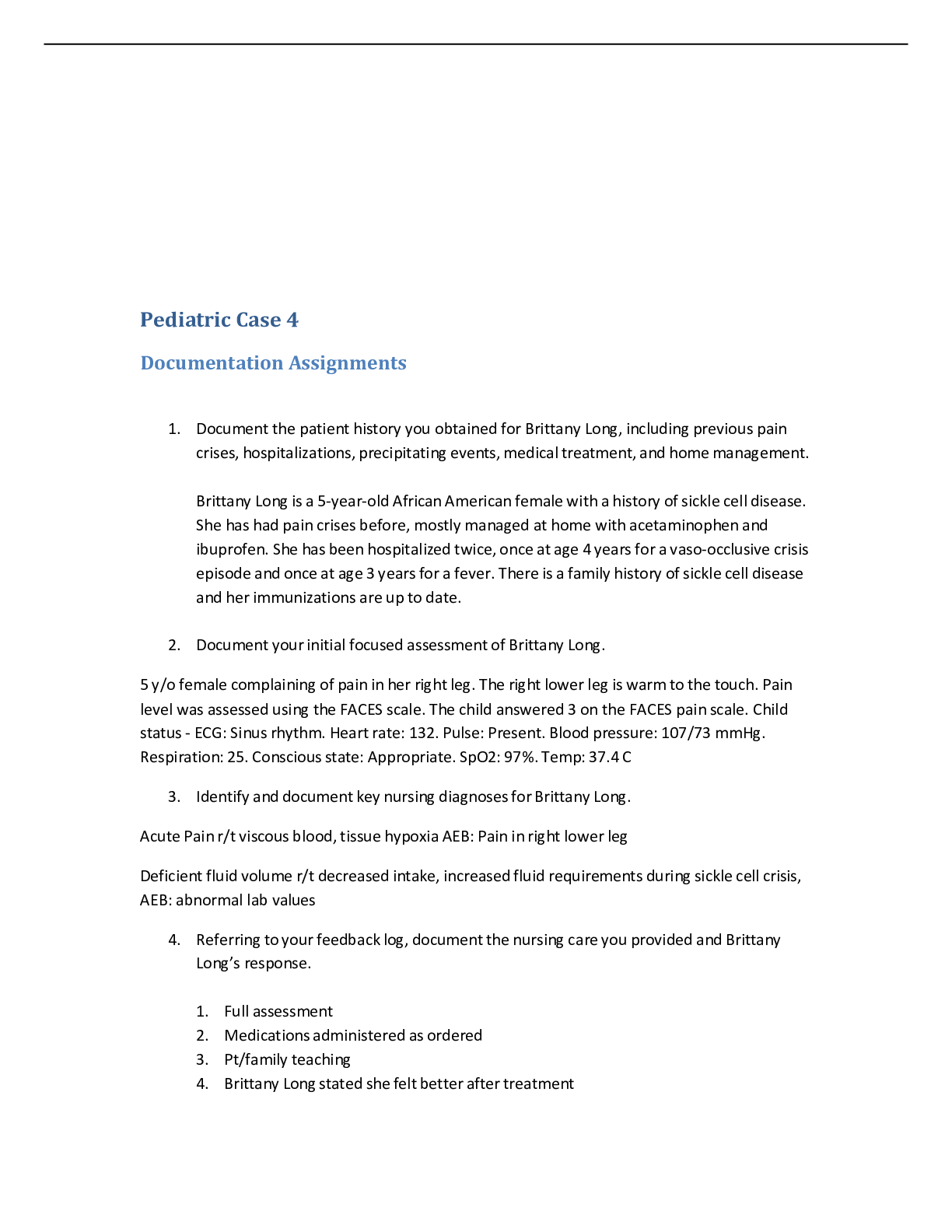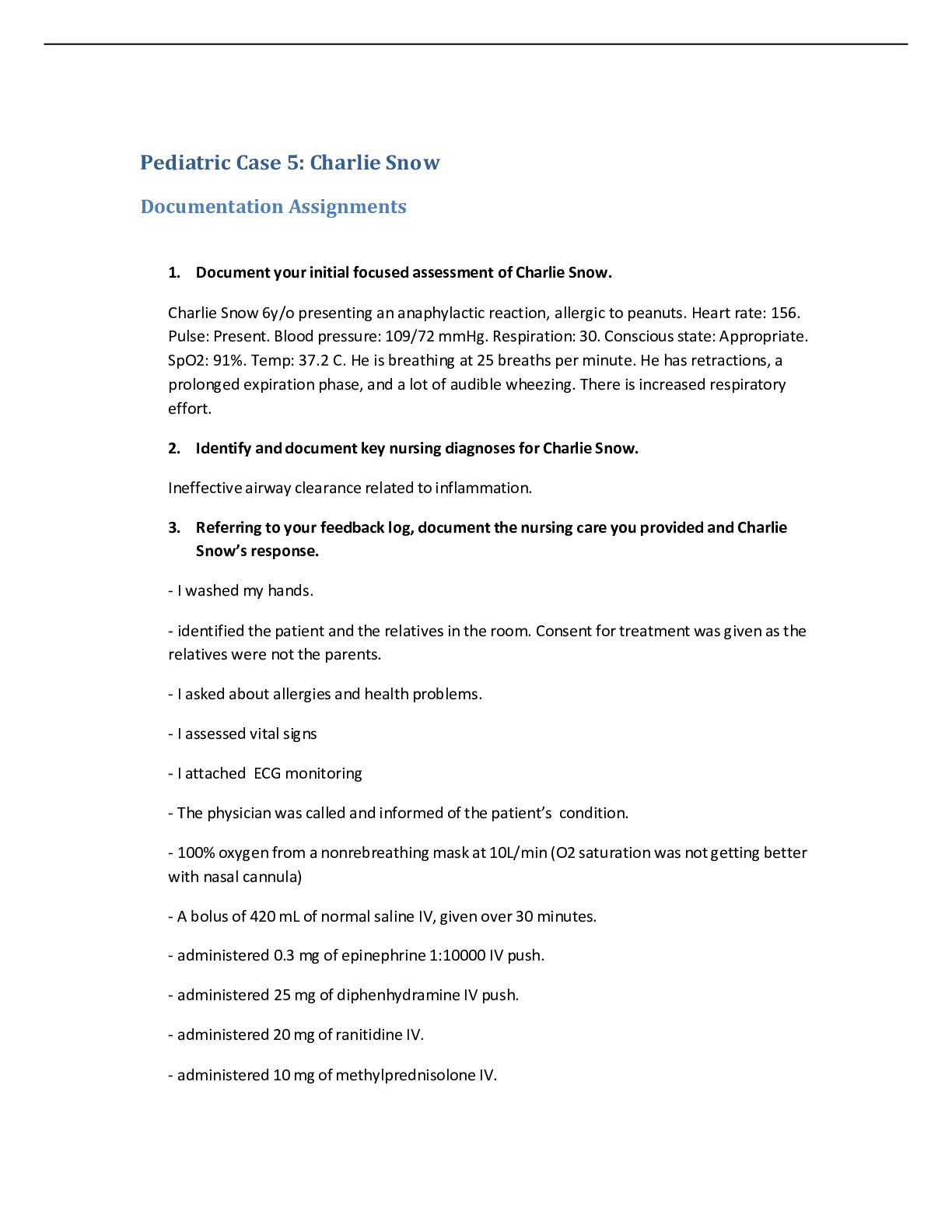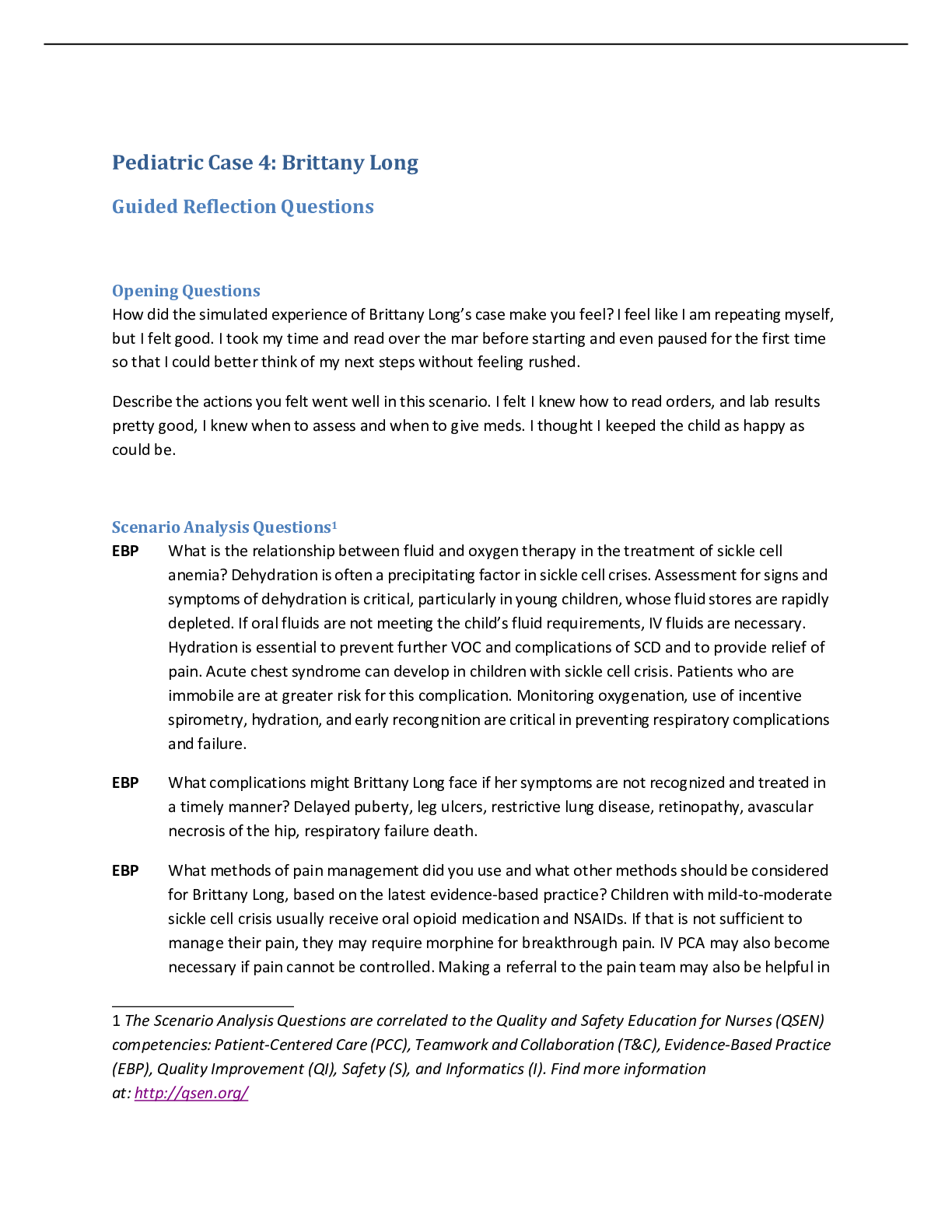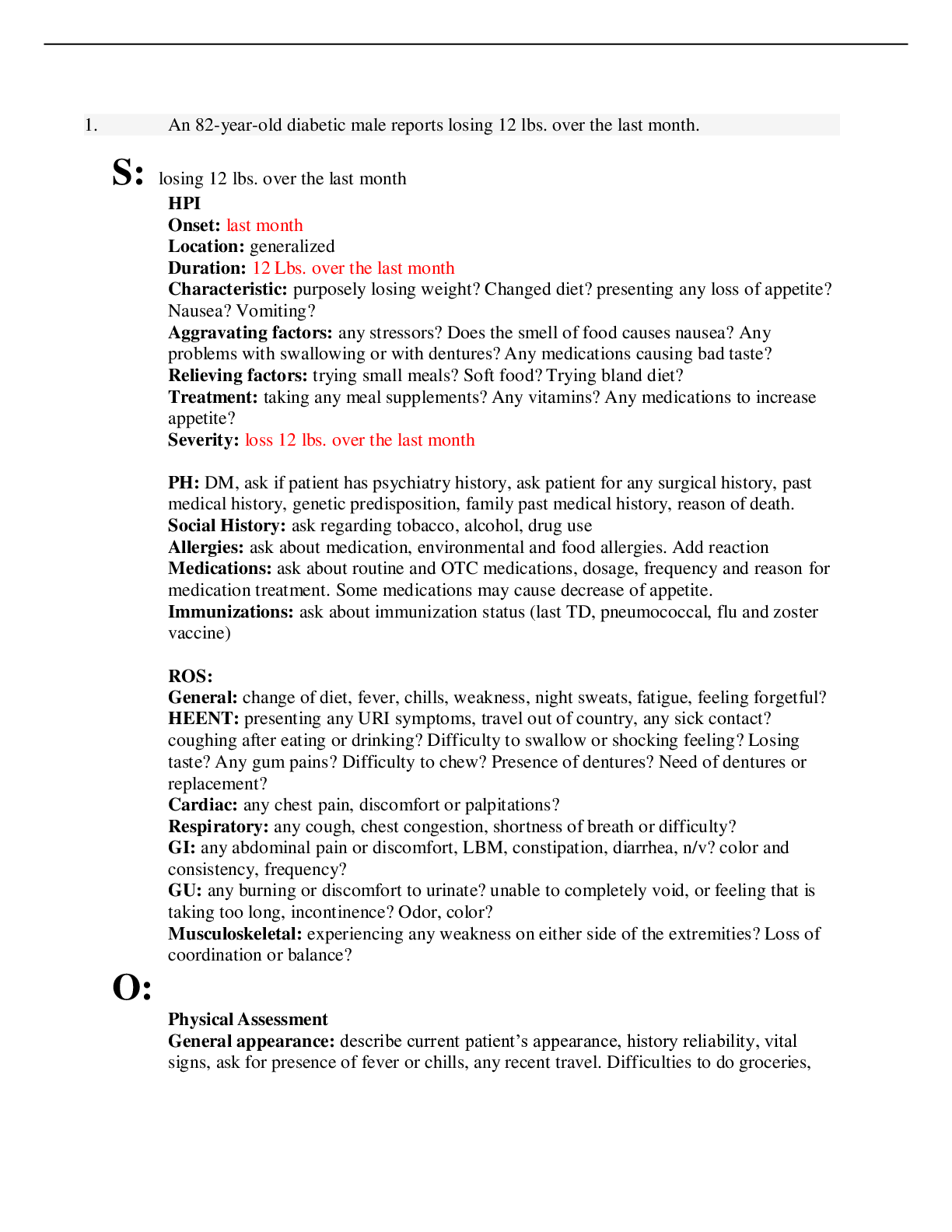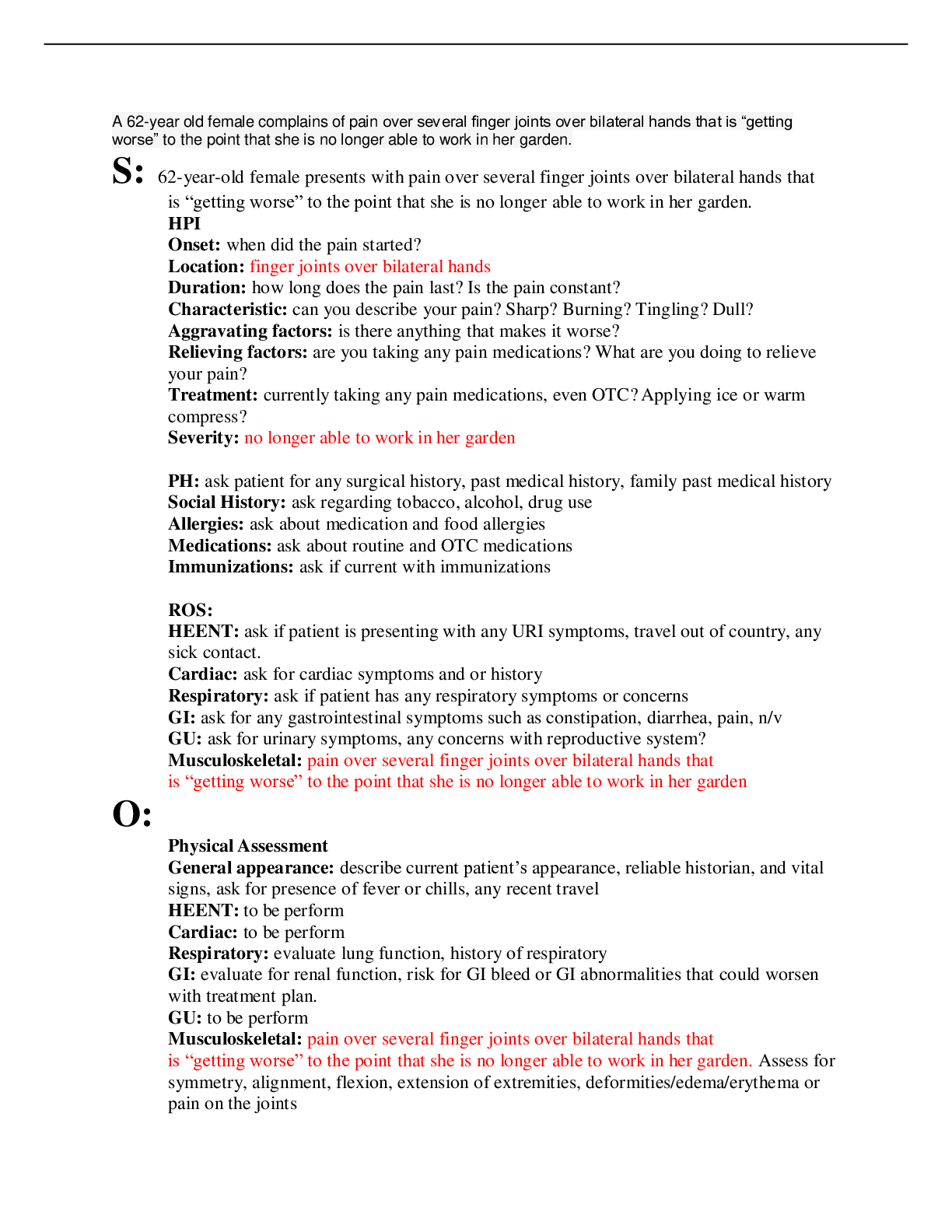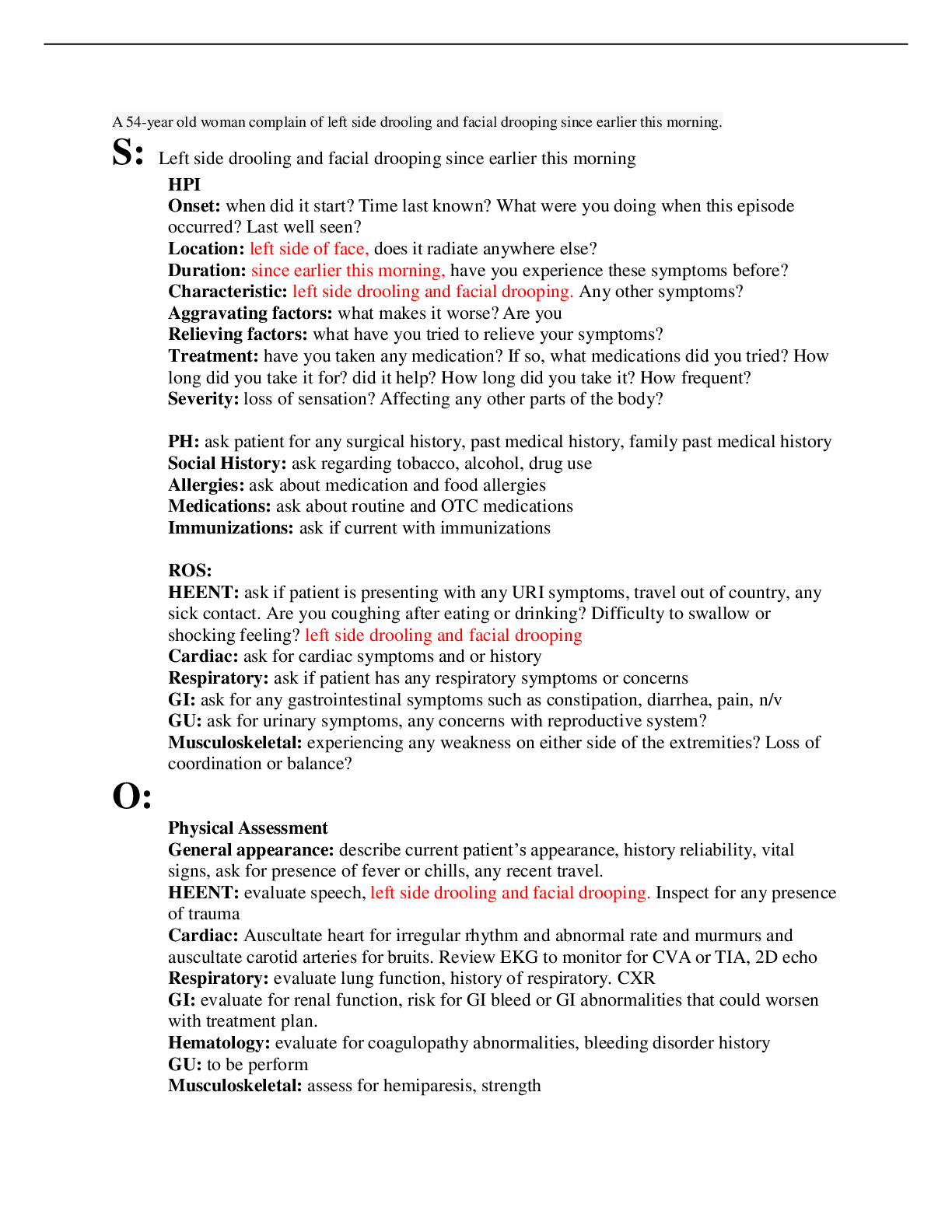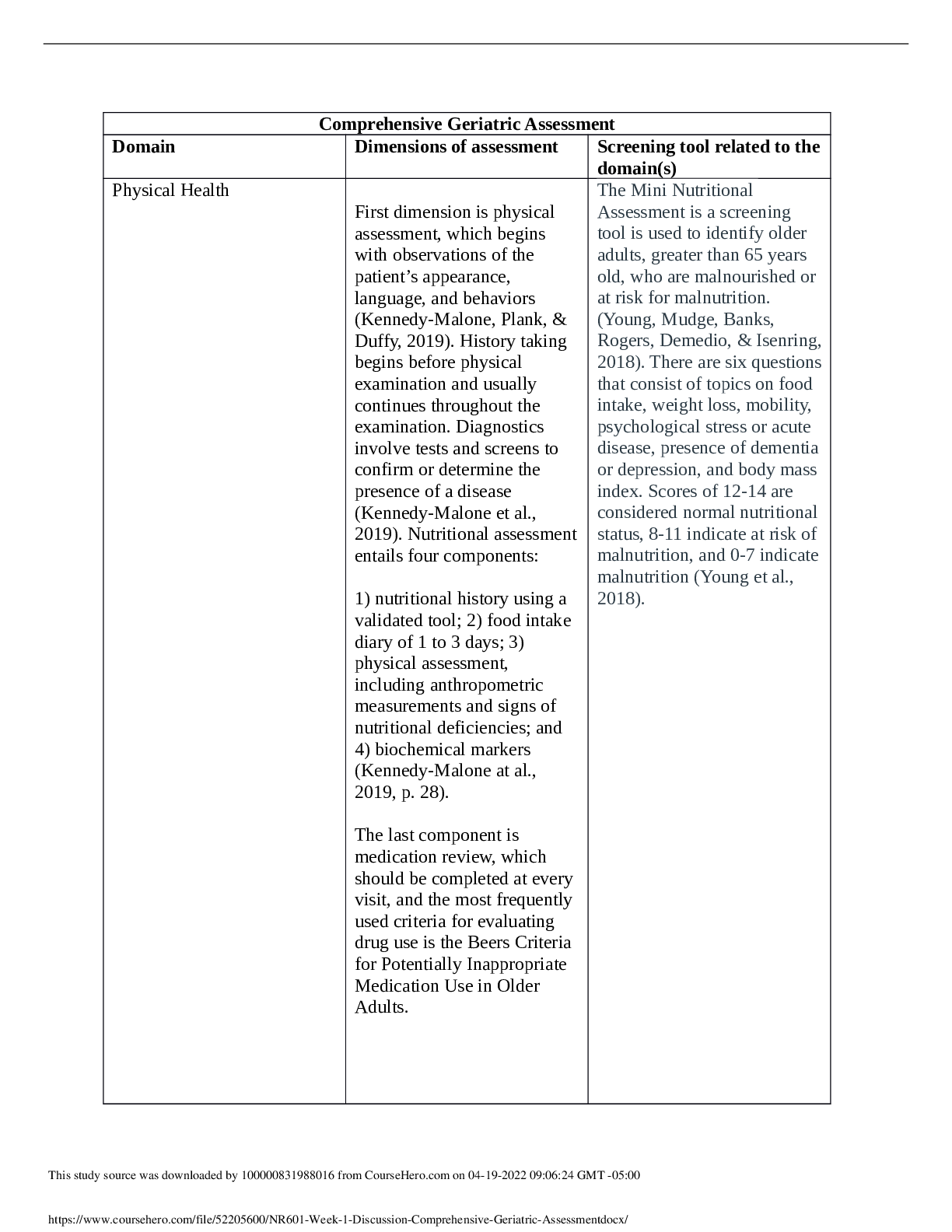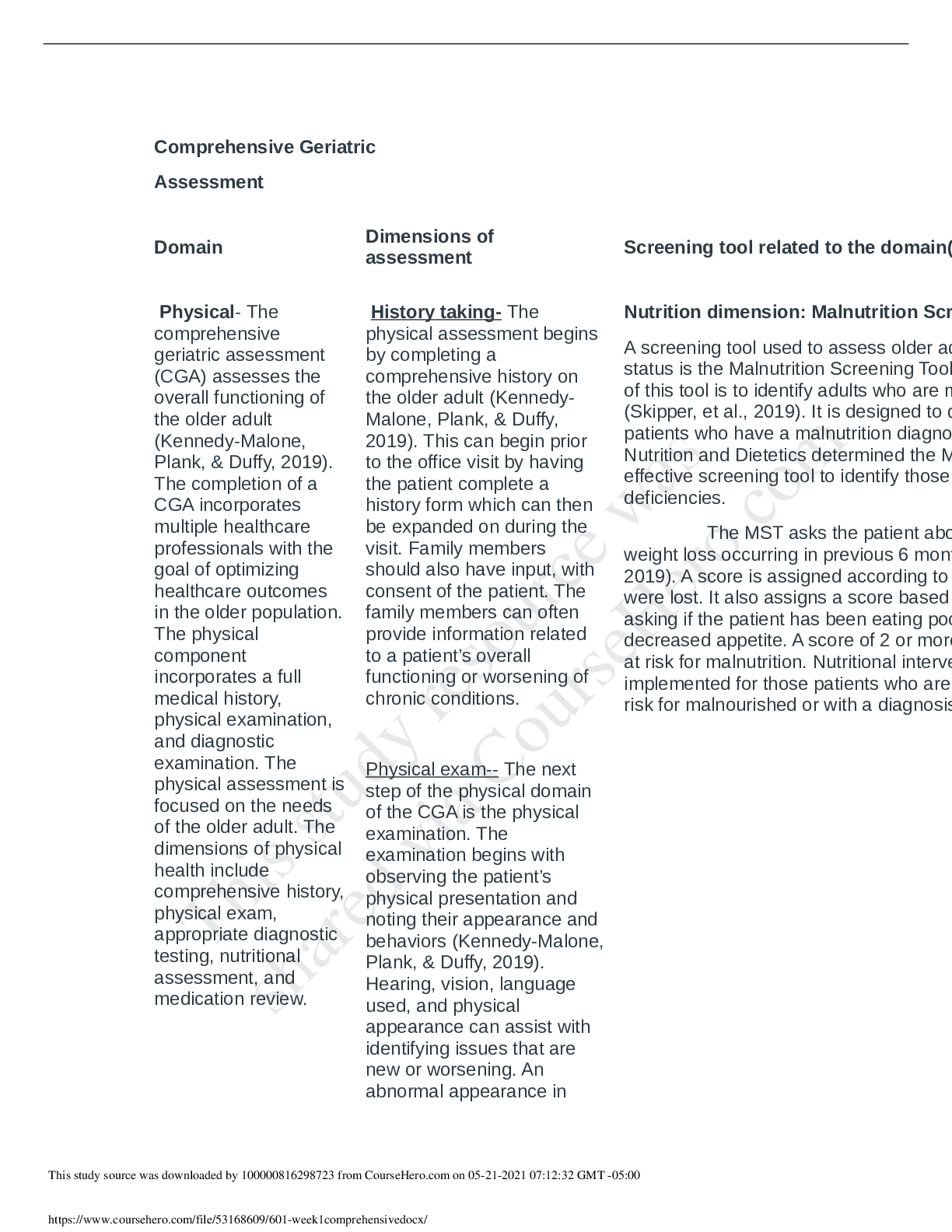*NURSING > CASE STUDY > NUA 460 - Week 1 Case Study./ Completed assignment (All)
NUA 460 - Week 1 Case Study./ Completed assignment
Document Content and Description Below
NUA 460 CLINICAL CASE STUDIES GROUP 4 WEEK 1 CASE STUDY Scenario T.R. is a 22-year-old college senior who lives in the dormitory. His friend finds him wandering aimlessly about the campus appearing... pale and sweaty. He engages T.R. in conversation and walks him to the campus medical clinic, where you are on duty. The friend explains to you how he found T.R. and says T.R. is “diabetic” and takes insulin. T.R. is not wearing a medical warning tag. It is 1015. 1. What do you think is going on with T.R.? a. Based on T.R.’s signs and symptoms, like the pale, sweaty appearance, as well as the 2. What is the first action you would take? 3. Which assessment findings would support the premise that T.R. is experiencing a hypoglycemic reaction? 4. If no glucose meter were available, would you treat T.R. on the assumption he is hyperglycemic or hypoglycemic? Explain your rationale. 5. It is 1025. T.R.'s glucose reading is 50mg/dL. What should your next action be? 6. When you enter the room to administer the juice, T.R. is not responsive enough to drink the juice safely. What should you do? 7. T.R. is breathing at 16 breaths/min and has a pulse of 112 beats/min and regular. Because outpatient resources vary, describe your next actions if (1) your clinic is well equipped for emergencies or (2) your clinic has no emergency supplies Case Study Progress A few minutes after administering 2mg glucagon, T.R. begins to awaken. He becomes alert and asks where he is and what happened to him. You orient him and then explain what has transpired. 8. What questions would you ask to find out what precipitated this event? a. The questions I would ask are “When did you last eat?”, “What did you have for breakfast?”, “How regularly do you check your blood sugar?”, “What kind and how much insulin, if any, did you take today?”, “Do you follow a special diabetic diet?”. These questions would give me the information I need to continue care. 9. What further action do you need to take at this time? a. Since T.R. is now awake and responsive, it would now be the time to give him some fruit juice and some food high in carbohydrates so that his status doesn’t further decline. It is important to give him more glucose so his status can keep improving. Giving the patient fruit juice, a meal with carbohydrates, and having him rest is essential in preventing a second hypoglycemic effect. 10. At 1045, you recheck T.R.'s glucose and the reading is 64mg/dL. His vital signs are 120/72, 18, 92. Has his status improved or not? Defend your response. 11. His blood sugar went from 50 to 64 mg/dL, and his vital signs are all within normal limits. His status has improved since he was first admitted to the clinic. Although his status has improved, he is still considered to be hypoglycemic, so it is important to take further action to prevent a second episode. What would your next action be? a. To prevent a second episode of hypoglycemia, I would make sure that a meal containing carbohydrates is given along with some fruit juice since he is alert and oriented. 12. At 1110, you recheck T.R.'s glucose and the reading is 104mg/dL. What should you do now? a. His glucose levels have improved greatly, this shows that the glucagon and food/juice that was given has worked as it’s supposed to. Although the levels are a little bit higher, they are better than they were before and he is stable for now. b. Case Study Progress T.R. tells you he took 35 units glargine (Lantus) insulin and 12 units of regular (Humulin R) insulin at 0745. He says he was late to class, so he just grabbed an apple on the way 13. Based on this information, why did T.R. experience this episode of hypoglycemia? a. Regular insulin is short-acting, which may be why he experienced hypoglycemia. 14. Based on your knowledge of the types of insulin T.R. is receiving, when would you expect T.R. to experience a hypoglycemic reaction? a. Lantus insulin is long-acting, so this was most likely not the reason for this episode of hypoglycemia. Since he is using this along with regular insulin, which is a short-acting one, this most likely caused it. The short-acting insulin has an onset of 30-60 minutes, so his hypoglycemia would be expected within that time frame. 15. He says he had two similar low-blood sugar episodes recently. He treated them by eating a candy bar. He says he is on a 2000-calorie, carbohydrate-controlled diet but has been checking his blood glucose levels every "couple of days" only. What common mistake in previously treated episodes of hypoglycemia did T.R. make? a. He is consuming foods that are rapidly converted to sugar in the body as they don’t have fats or protein. He should check his blood sugar shortly after eating, and he did not follow-up with his doctor after that first episode which was his mistake. 16. List at least four important points that you would stress in a teaching plan with T.R. a. Check your blood sugar every day. b. Don’t skip meals, especially breakfast. c. Exercise regularly to improve insulin sensitivity. d. See your doctor regularly and whenever you have an episode of hypoglycemia. 17. You instruct him to check his blood glucose at 1230 then eat lunch at the normal time. He is to follow up with you in 1 week to discuss how he is managing. You will determine that T.R. understands your teaching regarding hypoglycemia if he states: a. "I need to eat within 30 minutes of taking the regular insulin." b. "If I am too sick to eat, I will not take any insulin until I feel better." c. "Only certain kinds of alcoholic drinks will affect my blood glucose levels." d. "I will exercise just before eating and taking insulin so I do not get cramps." 18. Write a sample documentation note for the encounter with T.R. a. The patient T.R. was brought in to the clinic pale, sweaty, and confused. Patient was diagnosed with hypoglycemia. At 1025, patient’s blood sugar was 50 mg/dL and became unresponsive. 2 mg of glucagon was administered and patient recovered. At 1045, his blood glucose was 64 mg/dL. Patient was given orange juice and a carbohydrate meal. Blood glucose was redrawn at 1110 and it was 104 mg/dL. b. Patient takes 35 units glargine insulin and 12 units of regular insulin and only had an apple to eat that morning. Patient was educated to measure blood glucose after eating lunch and to follow-up with the clinic in one week. Patient was discharged. [Show More]
Last updated: 1 year ago
Preview 1 out of 3 pages
Instant download
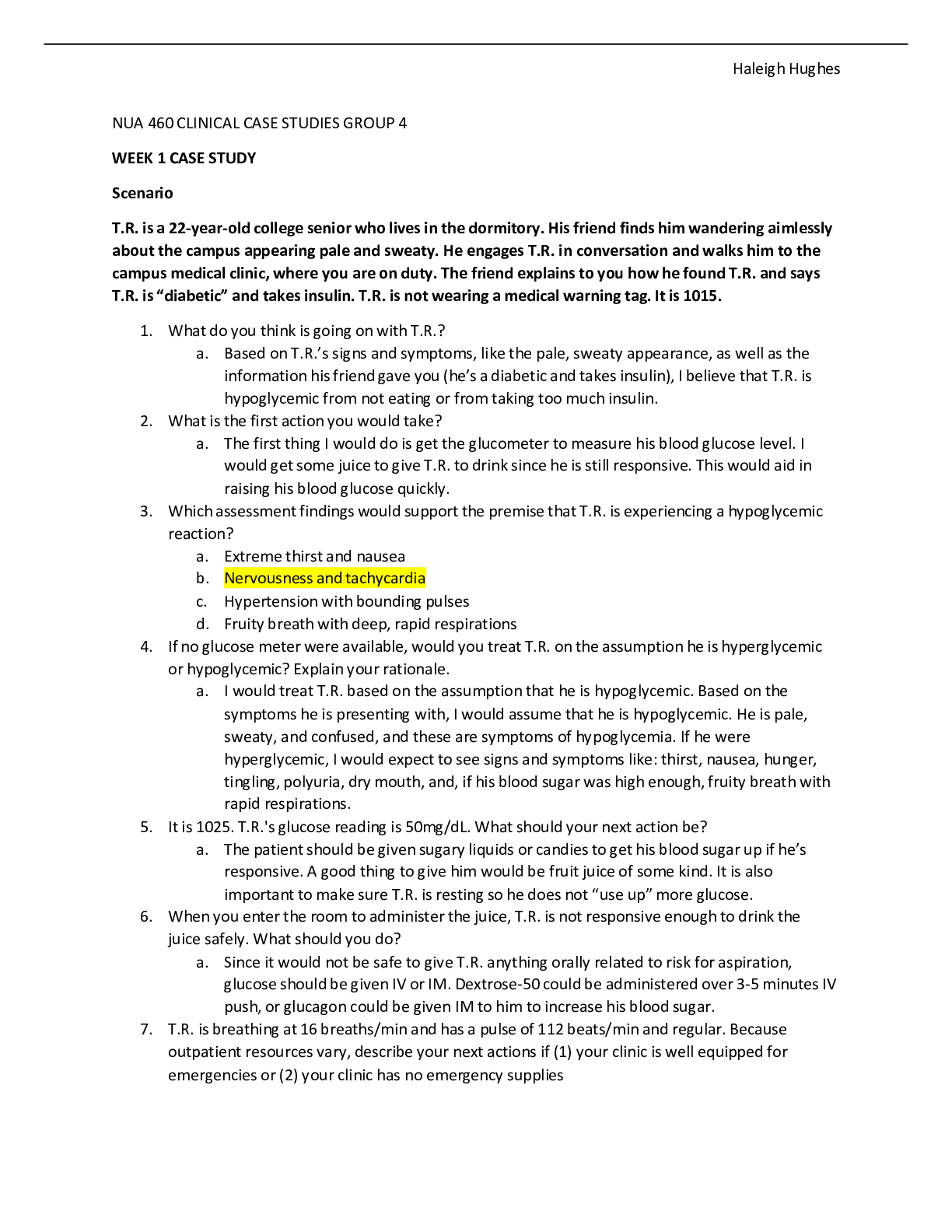
Buy this document to get the full access instantly
Instant Download Access after purchase
Add to cartInstant download
Reviews( 0 )
Document information
Connected school, study & course
About the document
Uploaded On
Aug 11, 2021
Number of pages
3
Written in
Additional information
This document has been written for:
Uploaded
Aug 11, 2021
Downloads
0
Views
43

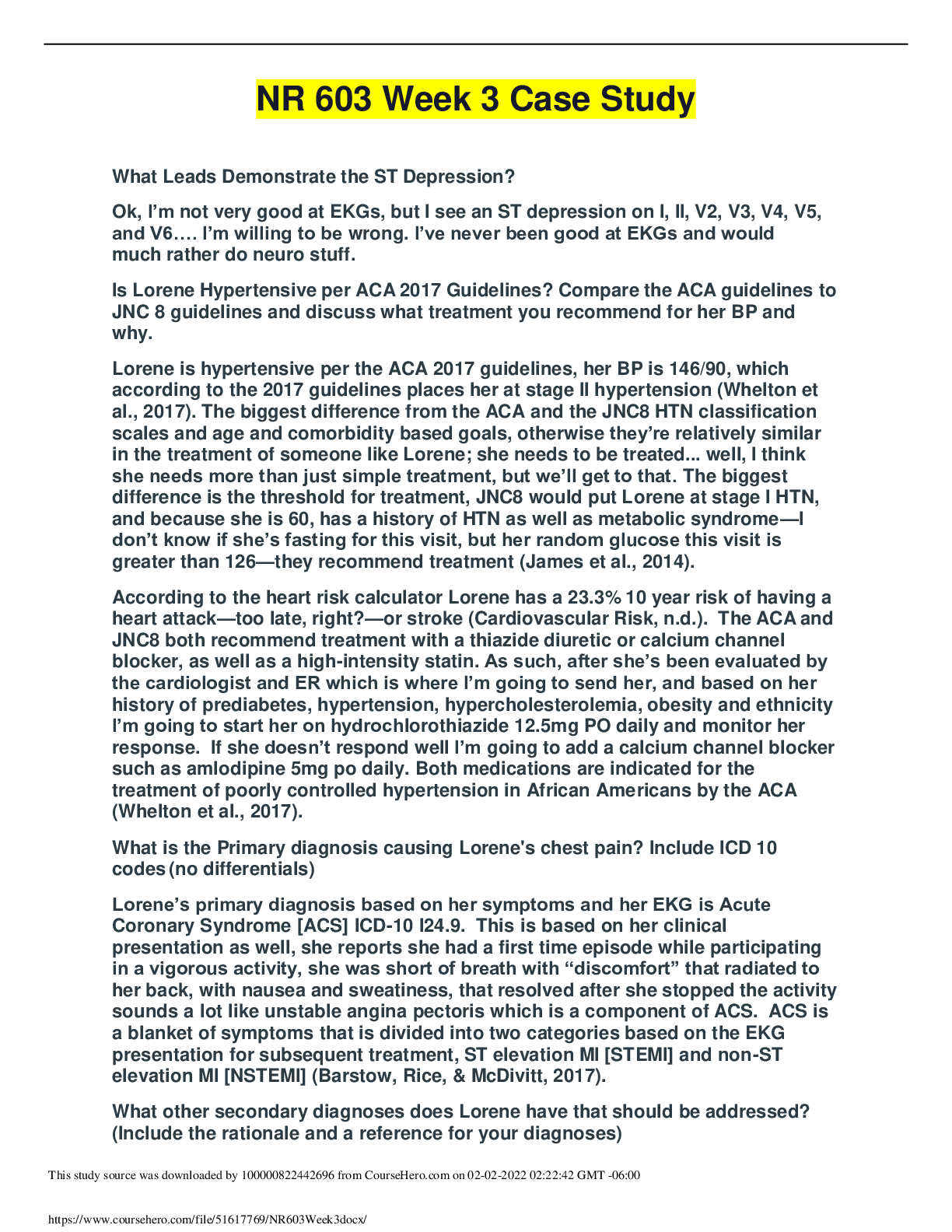
.png)
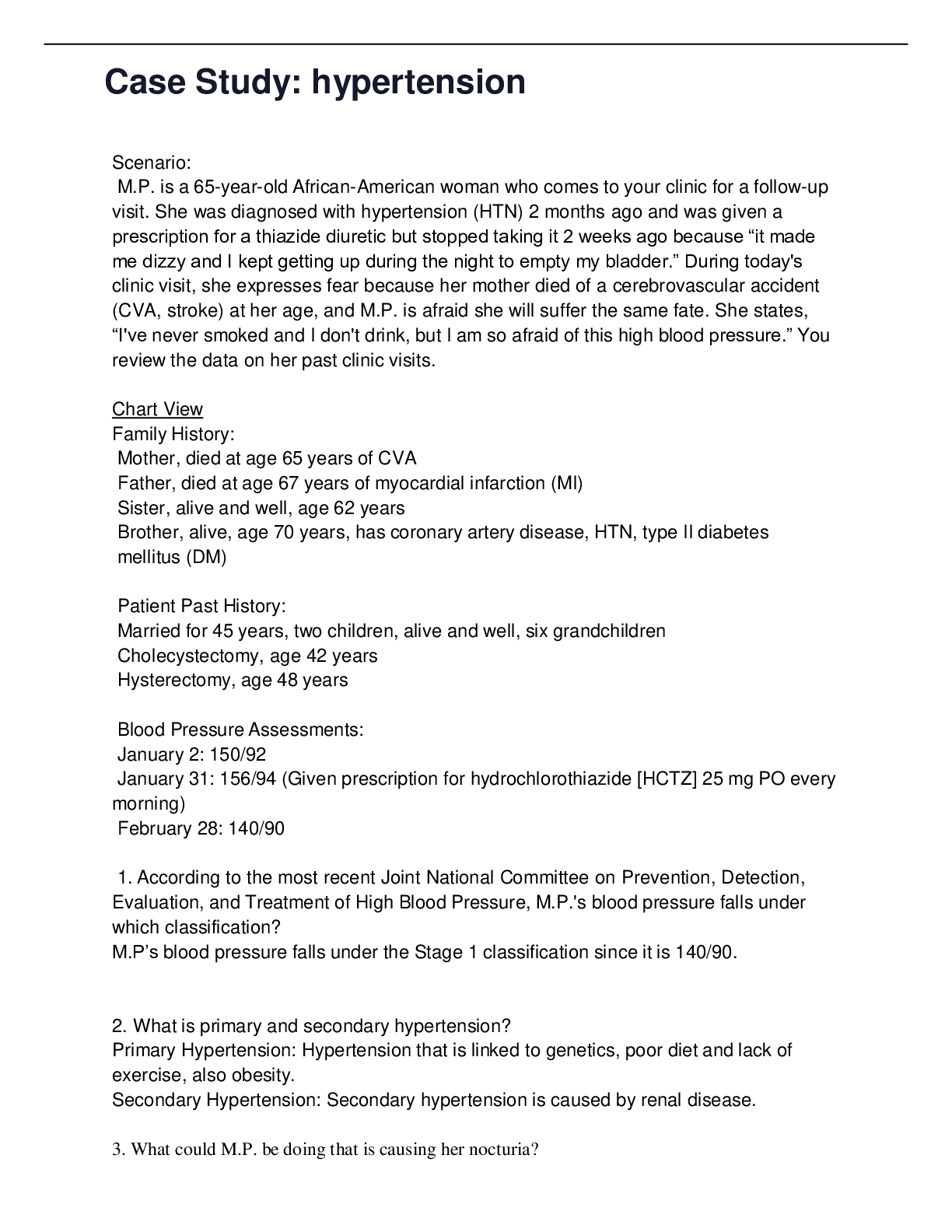

.png)
 (1).png)
